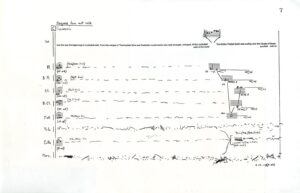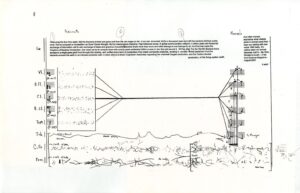The music of Morgan Powell, a trombonist and composer who taught at the University of Illinois between 1966 and 1994, pushed the outer limits of music notation and performance. Like Sun Ra’s music explorations, Powell’s musical sound sculptures grew directly from his performer’s interpretations of his graphic scores which often broke the rules of traditional music notation.
Perhaps inspired by his background in jazz, Powell incorporated into his experimental music compositions free improvisation and extended performance techniques that produced unique sounds on various instruments. These included multi-phonics which is the simultaneous production of multiple pitches on a single instrument by singing and playing at the same time, playing on mouthpieces alone, producing percussive effects on the bodies of horns, and unconventional violin bowings. All these specialized performance techniques required unique graphic notations to visualize the desired sound affect sought by Powell.

Page 7 of Common Root, illustrating the visual representation of the origin of life. Note the instruction at the top of the page which reads “progress does not rule.”
His 2003 work The Common Root of All Organisms — written for soprano soloist and an 8-piece ensemble consisting of violin, bass flute, clarinet, bass clarinet, trumpet, trombone, cello, and percussion — uses a five-line staff and specialized graphical notations that include scribbles, squiggles, circles, arrows, and jagged and branching lines. In addition, the score includes written instructions for musicians to produce a particular sound like a written word on a page for someone to read out loud. These symbols and directions provide suggestive directions for how a musician might produce a certain feeling or musical expression through their performance much like showing someone a painting and asking them to express its meaning through sound.
Common Root’s text tells the story of the creation of the earth and life’s subsequent evolution from single cells to complex organisms. The score illustrates this with chaotic scribbles and scratches in the early part of the piece when the earth is still forming. When the text portrays the development of new forms of life like birds and reptiles, Powell notates the musician’s improvised accompaniment with lines that continually branch from one another. The final pages of the score become much more organized and portrays through its lyrics and sounds the eventual evolution of modern science’s classification of life.

Page 17, where we can see the branching of the evolutionary tree as new forms of life develop from common ancestors.
Powell’s graphic score illustrates his careful attention to the intricate visual relationships between sound and human expression and challenges the traditional roles of composer and performer when creating new music. Traditional music notation lays out the composer’s instructions for the performer to reproduce the work exactly, down to every note and rhythm. Like a jazz chart, Powell’s score for Common Root puts the performer in the role of co-composer.
For further information about the Morgan Powell Music and Papers either email schwrtzs@illinois.edu or call 217-333-4577.
